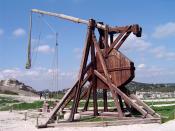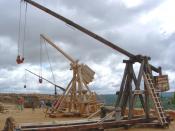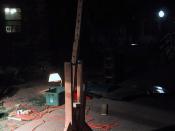TREBUCHET REPORT
Before gunpowder and bullets were invented, the trebuchet was the artillery machine that armies chose to fight with the most. In medieval times it was considered the deadly weapon. It became unnecessary when guns came along. Some machines were so big they could throw cows, sheep, horses, or even something as big as a car. Smaller machines were sometimes made that could hurl things the size of tennis balls, small bricks, rocks or pumpkins.
Many people think that trebuchets are catapults. This isn't true. A trebuchet is a counterweight machine that has a rotating mass. On one end there is a long sling and on the other side there is a large mass. The catapult uses tension from leather straps or twisted ropes to fling the arm forward. The arm is thrown against a stop where the object is released. Each time it was fired the machine had to be repositioned.
They also would bend and break using objects much smaller than the ones a trebuchet could throw. A trebuchet was more stable. It used counterweights which made it possible to have a complete transfer of energy to the object being projected. They also threw things further and harder than a catapult could. When opposed to a catapult, a trebuchet would win the battle every time.
The way you calculate the force is by remembering that the "torque equals force times length." The lever ratio should have a high fulcrum point with the best results being between 2:1 and 6:1. The projectile mass should not be more than 1/25th of the counterweight or less than 1/100th of it. The length should be a little less than the long end of the beam. If the rope is too short it will release too early but if it's too long...


